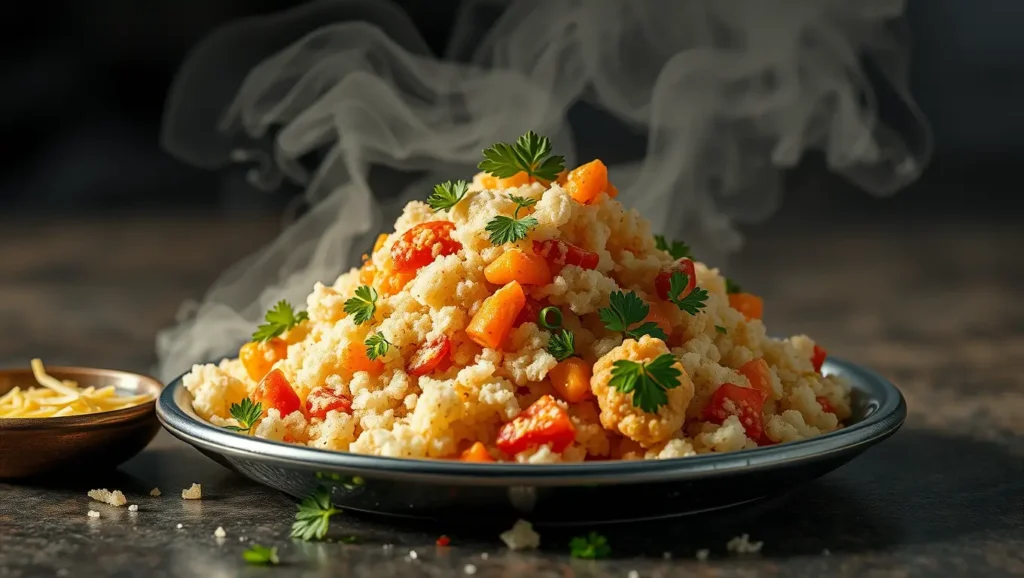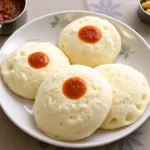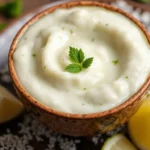Savoring South Indian Breakfast: Mastering the Art of Upma Preparation
Table of Contents
Introduction
Upma, a popular South Indian breakfast dish, is a delicious and nutritious way to start your day. This versatile semolina-based dish is not only easy to make but also customizable to suit various tastes and dietary preferences. In this comprehensive guide, we’ll walk you through the process of making perfect upma, step by step.
Ingredients
Here’s a table of ingredients you’ll need to make upma for four servings:
| Ingredient | Quantity |
|---|---|
| Semolina (Rava/Sooji) | 1 cup |
| Oil or Ghee | 2 tablespoons |
| Mustard Seeds | 1 teaspoon |
| Urad Dal | 1 teaspoon |
| Chana Dal | 1 teaspoon |
| Cashews | 10-12 |
| Curry Leaves | 1 sprig |
| Green Chili | 1-2, finely chopped |
| Onion | 1 medium, finely chopped |
| Ginger | 1 teaspoon, grated |
| Carrots | 1 small, finely chopped |
| Green Peas | 1/4 cup |
| Water | 2 1/2 cups |
| Salt | To taste |
| Lemon Juice | 1 tablespoon |
| Fresh Coriander Leaves | 2 tablespoons, chopped |
Step-by-Step Upma Preparation
- Roast the semolina: In a dry pan, roast the semolina on medium heat until it turns light golden and gives off a nutty aroma. This usually takes about 5-7 minutes. Set aside.
- Prepare the tempering: Heat oil or ghee in a large pan. Add mustard seeds and let them splutter.
- Add lentils and nuts: Add urad dal, chana dal, and cashews. Fry until they turn golden brown.
- Sauté aromatics: Add curry leaves, green chili, and ginger. Sauté for a minute until fragrant.
- Cook the vegetables: Add chopped onions and sauté until translucent. Then add carrots and green peas. Cook for 2-3 minutes.
- Add water and seasoning: Pour in the water and add salt. Bring it to a boil.
- Add semolina: Slowly add the roasted semolina while stirring continuously to avoid lumps.
- Cook the upma: Reduce heat to low and cook for 2-3 minutes, stirring occasionally, until the water is absorbed and the upma reaches a thick, porridge-like consistency.
- Final touches: Turn off the heat. Add lemon juice and fresh coriander leaves. Mix well.
- Serve: Let it rest for a couple of minutes before serving hot.
Nutritional Information
Here’s an approximate nutritional breakdown for one serving of upma:
| Nutrient | Amount |
|---|---|
| Calories | 250 |
| Carbohydrates | 40g |
| Protein | 7g |
| Fat | 8g |
| Fiber | 3g |
| Sodium | 300mg |
Note: These values may vary based on the specific ingredients and quantities used.
Tips for Perfect Upma
- Roasting semolina: Don’t skip this step as it enhances the flavor and prevents the upma from becoming sticky.
- Consistency: Adjust the water quantity based on your preferred consistency. For a softer upma, add slightly more water.
- Vegetable variations: Feel free to add or substitute vegetables based on your preferences or what’s available in your kitchen.
- Seasoning: Taste and adjust salt levels before serving. You can also add a pinch of sugar to balance the flavors.
- Ghee vs. Oil: While oil works well, using ghee can add a rich, traditional flavor to your upma.
Variations of Upma
- Vegetable Upma: Add more vegetables like bell peppers, tomatoes, or spinach for a nutrient boost.
- Rava Khara Bath: A spicier version popular in Karnataka, made with additional spices and vegetables.
- Wheat Upma: Replace semolina with cracked wheat for a healthier alternative.
- Oats Upma: Use oats instead of semolina for a fiber-rich breakfast option.
- Vermicelli Upma: Substitute semolina with vermicelli for a different texture.
For more Indian breakfast ideas, check out this collection of traditional recipes.
Frequently Asked Questions (FAQs)
- Can I make upma ahead of time?
Yes, you can make upma in advance and reheat it before serving. Add a little water while reheating to restore its consistency. - Is upma healthy?
Upma can be a healthy breakfast option as it’s low in fat and provides a good balance of carbohydrates and proteins. Adding vegetables increases its nutritional value. - Can I make upma without onions and garlic?
Absolutely! You can skip onions and garlic for a Jain or No Onion No Garlic (NONG) version of upma. - How can I make my upma less sticky?
Roasting the semolina well and using the right water-to-semolina ratio are key to preventing sticky upma. Also, avoid overcooking. - Can I use milk instead of water to make upma?
While not traditional, you can use milk for a creamier version. However, this will change the flavor profile of the dish.
Conclusion
Mastering the art of making upma opens up a world of quick, nutritious, and delicious breakfast options. With its versatility and ease of preparation, upma can become a staple in your kitchen. Experiment with different vegetables and spices to create your perfect version of this South Indian classic. Whether you’re looking for a comforting breakfast or a light dinner, upma fits the bill perfectly. Don’t forget to share your upma-making experiences and variations in the comments below!



